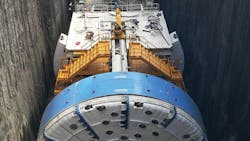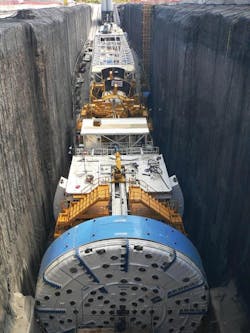Tunnel Reaches Two Miles Under Lake Michigan
Before beginning construction of the Oak Creek Power Station, situated about 10 mi south of Milwaukee, officials had to decide how to provide the plant with 2.2 billion gal of cooling water each day. The solution was to bore a tunnel 134-mi long tunnel about 200 ft below the bed of Lake Michigan to provide water to cool and recycle steam from the power plant’s turbines.
Creating this cavernous tunnel requires a tunnel boring machine (TBM), which comes in sizes from a few feet in diameter to mammoth machines hundreds of feet long that bore tunnels more than 20-ft in diameter.
For this project, Kenny Construction Co., Northbrook, Ill., a major subcontractor, commissioned a TBM from The Robbins Co., Solon, Ohio. Capable of excavating a tunnel more than 27 ft in diameter, the TBM uses electric motors to rotate its massive cutting head. To ensure that the cutting head rotates — rather than the body of the TBM — brake shoes are deployed hydraulically to wedge the TBM body against the walls of the tunnel. The brakes also prevent the body of the TBM from being pushed backwards as cylinders behind the cutting head transmit millions of pounds of thrust to push the cutting head forward.
Sensitive to the environment
Lake Michigan is among the largest bodies of fresh water in the world, a source of drinking water for millions of Americans, and an important fishery and recreation resource. Therefore, all aspects of the tunneling project were carefully assessed for potential environmental impact, including the choice of hydraulic fluid used in the tunnel boring operation.
Tunnel boring machines normally use hydraulic oil to actuate the massive hydraulic cylinders and other components of the system. However, considering the potential consequences from oil spills and leaks in this application, officials at Kenny Construction turned to global fluid supplier American Chemical Technologies (ACT), Inc., Fowlerville, Mich., for assistance in identifying the right fluid.
“Because the project would be regulated closely by state and federal authorities for its impact on the environment, we recommended UCON Trident AW fluid, an eco-friendly product that would also meet Kenny Construction’s stringent performance needs,” said Kevin P. Kovanda, ACT president, whose company is the exclusive distributor for the fluid. Tom Peterson, TBM specialist at Kenny Construction, agreed that the Dow ISO 46 formulation was selected because of its favorable environmental profile as well as essential load carrying, heat, and wear performance characteristics.
With the high pressures and flow rates of the application, a relatively small leak from a hydraulic line or a seal could quickly discharge large amounts of fluid into the tunnel while going undetected. If a spill does occur, on-site clean-up is extremely difficult because the fluid becomes mixed with a slurry of pulverized rock and soil produced by the boring operation. The mixture is then carried to settling basins on the surface, where it can complicate secondary wastewater treatment as well.
Using a fluid with a favorable environmental profile and low toxicity can help minimize the impact of leaks or spills as well as simplify water treatment requirements. For example, UCON Trident AW Fluid readily dissolves in water, which can reduce the need for centrifuging, flocculant or other wastewater treatment operations.
In addition to a favorable environmental profile, UCON Trident AW Fluids also provide the necessary load carrying, heat and wear performance critical to tunnel boring operations, Kovanda said. He said that the fluid performed so well in the tunnel boring operation on the Oak Creek project that it was subsequently installed by contractors in a variety of other construction and mobile equipment across the project site.
For more information on Dow’s UCON Trident AW fluid, e-mail Brian Goldstein at [email protected]. Click here to download a PDF spec sheet on UCON Trident AW 46 hydraulic fluid.
Click here to see a video about UCON Trident AW hydraulic fluid.


